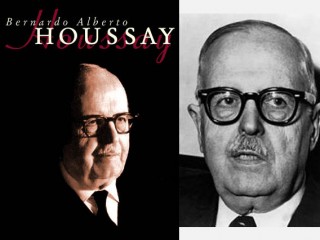
Bernardo Houssay biography
Date of birth : 1887-04-10
Date of death : 1971-09-21
Birthplace : Buenos Aires, Argentine
Nationality : Argentine
Category : Science and Technology
Last modified : 2011-01-20
Credited as : Physiologist, Nobel Prize for Physiology or Medicine, Glucose
The Argentine physiologist Bernardo Alberto Houssay is noted for his research in endocrinology, particularly on the activity of the hypophysis.
Bernardo Alberto Houssay was born in Buenos Aires on April 10, 1887. His father, Alberto Houssay, was a French-born lawyer and philosopher. Young Bernardo was a prodigy: by the age of 9 he had completed secondary school and was a mere 13 when he received his bachelor's degree. He then entered the Buenos Aires College of Medical Sciences, specializing in pharmacology, a concentration which was to be reflected in many of his research papers over the next 60 years. In 1904 he completed these studies and began medical training.
Houssay graduated with honors in 1911, presenting for his thesis an elaborate study of the pituitary body. These early studies marked Houssay as a laboratory researcher rather than as a practitioner of medicine. He was named professor of physiology in the Faculty of Veterinary Medicine and Agronomy of Buenos Aires, and in 1919 he was appointed to the first full professorship in the Buenos Aires School of Medicine. Under Houssay's direction the Institute for Physiology was established, where for over two full generations he labored on a frontier of biology. Following clues observed in his early student years, he tracked down the elusive hormonal and enzymatic systems that regulate the body's metabolism.
In 1947 Houssay received the Nobel Prize. In his acceptance speech he described how observations on the hypophysis, or pituitary body, made during his student days, had led him to his lifelong research program. "The production and consumption of glucose and hence the sugar level are controlled by a functional endocrine equilibrium. The endocrine glands are ductless glands secreting hormones into the bloodstream. This mechanism acts on the liver— the organ which produces and stores glucose—and on the tissues which are the consumers of glucose, by means of hormones which play a part in the chemical processes of carbohydrate metabolism. … I was attracted to the study of the hypophysis because the microscopic picture showed that glandular activity, and its lesions, was accompanied by serious organic disturbances such as acromegaly, dwarfism, etc."
Houssay had been expelled from his university post in 1943 during Juan Perón's regime but continued his research with private support. He was reinstated after Perón's overthrow in 1955. Houssay died in Buenos Aires on Sept. 21, 1971.
Houssay published over 1, 000 research papers. Perhaps his life is best told, not by listing his prizes, honorary degrees, memberships in scientific academies, and other plaudits, but in listing the topics which his work has benefited. These include pituitary anatomy and physiology, diabetes and the role of insulin, hormone biochemistry, the pancreas, general endocrinology, the renal glands and adrenalin, the thyroid and its secretions, hematology and immunology, cardiology, human metabolism and problems of nutrition, snake venom, the venom of spiders and other insects, respiratory functions, hypertension from a biochemical point of view, biology of the sexual functions, comparative physiology, and the physiological action of curare.
A short biography of Houssay and his Nobel lecture are in Nobel Foundation, Physiology or Medicine: Nobel Lectures, Including Presentation Speeches and Laureates' Biographies (3 vols., 1964-1967). The technical problems of carbohydrate metabolism which led to Houssay's Nobel Prize are analyzed in Herman M. Kalckar, comp., Biological Phosphorylations: Development of Concepts (1969). Further insights and additional references may be found in Philip Handler, comp., Biology and the Future of Man (1970).
















